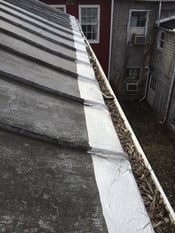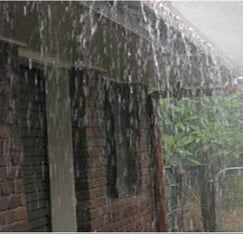From drips and leaks to gutters that aren’t draining properly, there are several problems that affect the way your gutter system works. The following issues are common among both residential and commercial gutters, but fortunately, each problem is relatively easy to fix. We’ll show you the signs that indicate a faulty gutter system and a few ways to fix the problem once you’ve located it.
Slow Drainage or Overflowing Gutters

When gutters are draining slowly or overflowing, the problem is usually a clog. However, the clog itself might not be so obvious. If you’ve cleaned debris out of the gutters, but the problem persists, the next place to look is the down spouting or possibly the underground drain pipes – especially around tees and elbows. Fix clogged down spouting by taking apart the clogged section and flushing away the debris. For buried piping, use a drain snake to break up the clog.
Sometimes it’s not a clog that is causing your drainage problem, but the gutter system itself. If the gutters, down spouts and drains are undersized compared to the demands placed on them, you’ll need to upgrade your gutter system to resolve the issue.
Pooling Water
 Pooling water leads to several problems - the gutters will rust faster, debris will collect where the water pools, and the moisture may cause the fascia to mold or rot. Pooling water is a sure sign that the gutters aren’t sloped in the right direction – gutters with the correct pitch should never hold standing water.
Pooling water leads to several problems - the gutters will rust faster, debris will collect where the water pools, and the moisture may cause the fascia to mold or rot. Pooling water is a sure sign that the gutters aren’t sloped in the right direction – gutters with the correct pitch should never hold standing water.
There are two ways to correct this problem. If the pitch is only slightly off, you may be able to remove and refasten some of the hangers. To correct larger pitch problems, you’ll need to remove the gutters and rehang them properly. Remember, gutters should slope toward the down spouting by at least a quarter inch per 10 feet.
Leaking Commercial and Residential Gutters
Any number of things can make a gutter system leak – storm damage, rust, loose seams and more. The first sign that you’ll notice is water dripping around the edges of the building, but only in particular locations. The leak is sometimes tricky to spot – water can flow for quite some distance along the bottom of the gutter before falling to the ground. Start where the water is dripping, and work your way to the higher end of the gutter, repairing and replacing sections as necessary.
Water Overshoots the Gutters
On any steeply sloped roof – usually residential gutters, but also sometimes commercial gutters – there is a chance that rainwater will overshoot the gutter system. Three problems will cause this to happen:
 The front edge of the gutter isn’t properly aligned with the pitch of the roof. Check the alignment by laying a straight edge on the roof. The front edge of the gutter should line up with the straight edge. If the gutters don’t meet the straight edge, you’ll need to correct either the roof overhang or install larger gutters.
The front edge of the gutter isn’t properly aligned with the pitch of the roof. Check the alignment by laying a straight edge on the roof. The front edge of the gutter should line up with the straight edge. If the gutters don’t meet the straight edge, you’ll need to correct either the roof overhang or install larger gutters.- Sometimes the roof overhang is longer than it should be. If the roofing material extends more than half an inch past the drip edge, trim the overhang back to expose more of the gutter.
- Roof valleys channel a large volume of water, which means that overshoots are common below valleys. Install deflectors to slow and redirect the water.
When gutters leak, hold water or overflow, it’s not merely an inconvenience, but a threat to both the gutter system and the structure. Correct problems as you find them, and you’ll extend the life of the gutter system while preventing water damage to the building.







